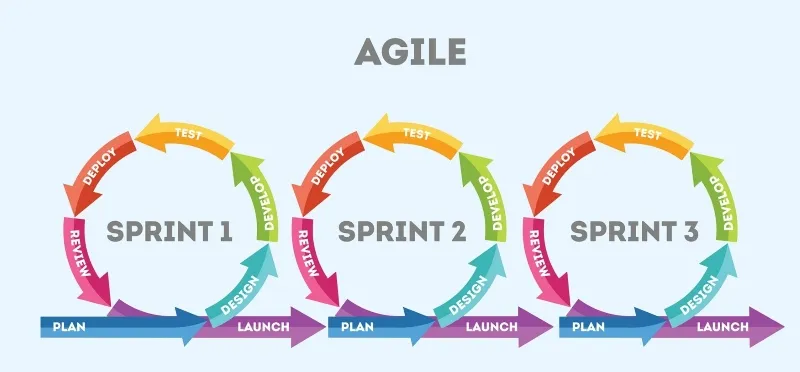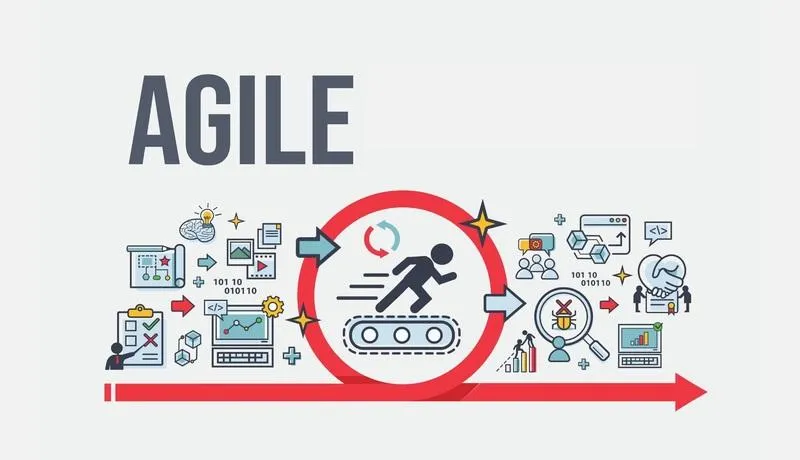1. What is the Agile Model?
First, let's learn about the Agile model with Vietnam Manpower . Basically, Agile is an iterative model: businesses will break a large project into small tasks to be performed in a fixed time (sprint). As a result, the project management process becomes simpler and easier, and businesses can better prepare for the project.
Especially in case the customer changes goals, the Agile model will allow businesses to evaluate the task they are doing and make adjustments step by step. y.
The advantages and potential of Agile project management are immense. The model helps to reduce the time between jobs, speeding up the project. In recent times, more than half of the 19 countries surveyed have adopted the Agile model . Besides, many other businesses are also choosing Agile methods to be able to keep up with the work progress in the future.

Agile model allows to break down the project into smaller tasks
1.1 Characteristics
The value that the Agile model brings to the operation and management of projects is immense. Here are 7 typical features of the model that readers can refer to:
- Evolution: With the Agile model, separate tasks and small jobs can be done and completed in each sprint by separate and independent teams. Over time, the sequels will grow slowly until it meets what the customer requires.
- Iterative: Agile model breaks down large work into smaller work pieces and repeats in a specific time period. In each of those subsections, each individual or team will be tasked with planning, researching customer requirements, building and implementing the project, and finally evaluating the results.
- Self-organizing team: Independence, independence, not being dependent are typical characteristics of a team of personnel in the Agile model. Faced with a set amount of work, each member of the organization actively plans to do their own work and ensure the best overall results.
- Adaptability: Each small piece of work will be done in a fairly short fixed period of time, so members must be highly adaptable.
- Transparency: In the Agile model , communication plays a very important role. Transparent communication helps connect project members, including customers. Thereby, the implementation process will become clearer and smoother, limiting the "bottlenecks" due to not detecting problems in time. Work results are also more optimized, reducing the need for many repairs.
- Values-based development: Values-based development is built around the interaction between the development team and the person making the requirements for the product/work. With this feature, the execution team will prioritize the important work and eliminate the unnecessary.

Agile methods can be easily changed and adjusted according to customer requirements
1.2 Principles
When using the Agile model , readers should pay attention to the following key principles:
- Willingness to accept changes even when the project is in the final stages of implementation.
- Prioritize the implementation of the work according to the timelines that are not too long.
- Always keep interaction and connection between team members as well as requesters for products/work.
- Prioritize direct communication to convey information most effectively.
- Always support other individuals, aiming for the best overall outcome.
- Always assign work to ensure the project is implemented on schedule.
- Agile models often have long-term stability and continuity.
- Simplify workloads by finding solutions to eliminate or replace unnecessary work in the project.
- Creative, proactive and independent at work.
- Teams will make periodic evaluations to find effective methods as well as correct unsuitable work.

The time for each small job should be from a few weeks to a month
2. Benefits of Agile model in projects
2.1 Provide complete data
The Agile model allows the project's information to be updated transparently, fully about customers, markets, and inside the company. From there, the management and employees have an overview of the project.
2.2 Satisfied customers
Agile model is customer-centric, so all feedback and needs of customers will be listened to and improved and changed in the software implementation process, thereby bringing usefulness and convenience. use for users. Sometimes customers only have an overview of the product, but in the process of communicating and working, Agile will connect the team and customers to help the product better than expected.
2.3 Effective teamwork
Agile encourages employees to focus on the project to deliver the best product. For example, in the Scrum method, there will be a Scrum Master who plays the role of ensuring that the team works effectively, eliminating distractions for employees.
2.4 Make changes quickly
The Agile model divides a project into several independent and parallel sub-phases. The members of the groups are well aware of the data and information of each stage. As a result, the teams of each sprint can flexibly respond to any changes.
3. Advantages and disadvantages of Agile model
Below, let's take a closer look at the advantages of the Agile model as well as the disadvantages that this model still exists.
| Advantage | Defect |
|
|

The Agile model has advantages that bring great benefits to businesses
4. Agile project management methods are most commonly used and widely used today
4.1 Scrum Method
What is Scrum ? Scrum helps manage and control all iterative projects. This is a method of breaking down a project into smaller pieces and managed by a Scrum Team for a predetermined time. To create a Scrum Team, we need to define the scrum master, product owner, and product goal.
4.2 XP method
XP aka eXtreme Programming, is the ultimate programming method. XP helps businesses develop products that improve quality and ensure products can meet the constantly changing needs of users. People often apply XP to programming techniques, teamwork, and clear communication to create the best product.
4.3 Kanban Method
What is Kanban ? Kanban is a tool to help visualize the tasks that departments need to do through specific stages to improve overall efficiency, especially when there are many tasks at the same time. In production, Kaban again becomes a tool to control the line, specifying the different stages and production materials through the color shown.
4.4 DSDM . method
DSDM is also known as Dynamic Systems Development Method. The most prominent feature of DSDM is that it allows users and stakeholders to actively participate in the software development process, and the development team is empowered to make decisions in the project. The DSDM method strictly adheres to 8 principles: cooperation; timely delivery; focus on business needs; proven control; clear, continuous communication; no loss of quality; iterative development; creative in fundamental steps.
4.5 FDD method
FDD is a feature-driven development approach that creates a very short iterative process that is tied together. After defining the overall shape model, the FDD project team will cross out a feature list and break them down into specific workflows. The advantage of this method is that it can be scaled, used effectively with large groups, and helps to shorten the implementation time.
5. Agile model implementation steps
So what steps does the Agile model implementation process include? Readers can refer to the following 6 steps in applying the Agile method.
- Build a project plan
Similar to other projects, first, the development team must determine what the end goal, the value that the project brings to the customer. The team must then map out the work that needs to be done to achieve the set goal. It should be noted that in the process of applying the Agile model , these implementations can completely be adjusted to better suit the change in demand.
- Set up product roadmap
Product roadmaps are understood as important stages and milestones on the journey to create the final product. At this stage, the implementation team needs to build the most specific and complete roadmap to be able to produce the perfect final product.
- Develop release plan
One of the differences between the traditional Agile and Waterfall models is that the Agile model allows the implementer to complete a specific feature/work after each short period. Instead of having to wait months or years to see the final product, the implementation team and stakeholders can visualize through features completed in short cycles.
So, before starting project implementation, develop a plan for feature releases. From there, stakeholders can easily access and reevaluate the release plan for each of those features.

Agile model implementation steps
- Plan each sprint
Before each Sprint begins, the relevant departments must plan the Sprint and determine what needs to be done. Note, it is necessary to divide the task evenly among the individuals in the team to ensure the task is completed on time before the sprint time.
- Evaluate project performance daily
Operating projects according to the Agile model requires the implementation team to hold daily short meetings and exchanges to evaluate and consider work. In that exchange, each person will briefly inform about the work they are undertaking, if there are any difficulties or problems.
- Sprint Review
At the end of each Sprint, the implementation team will hold two meetings. It is a meeting with relevant departments to check and accept the finished product, and a face-to-face meeting for the parties to discuss product problems (if any).

Review Sprints and discuss product issues












Replies to This Discussion